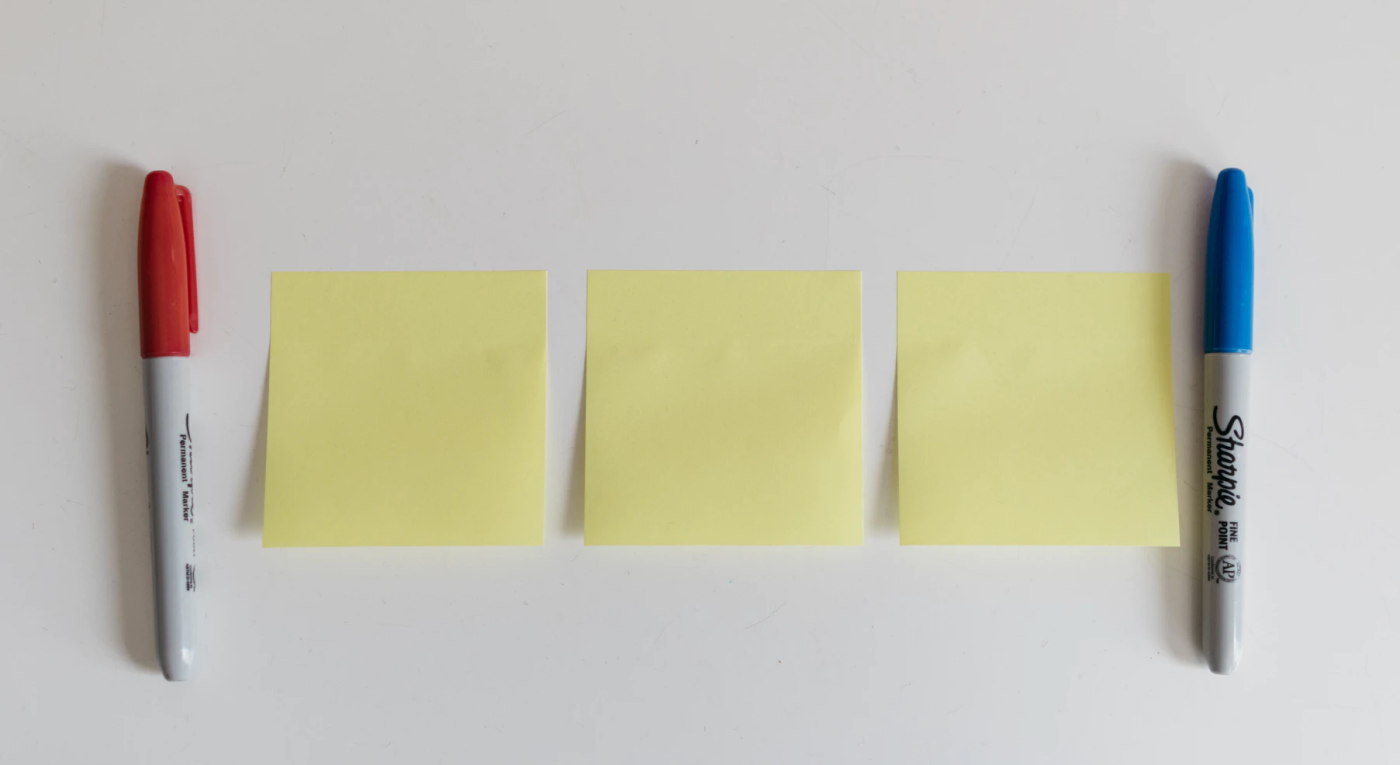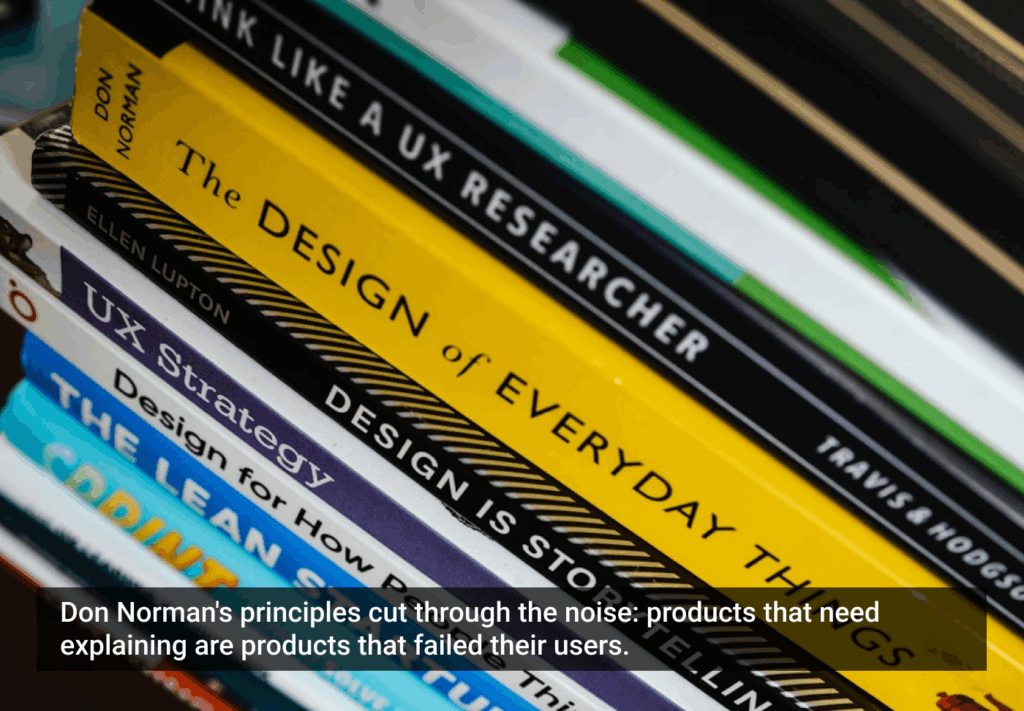Overview: This article will tell you in detail how I have gone through the entire process to understand the behavioral change that the pandemic has brought to the people who are trying to plan their vacation and how I provided a solution for their safety while traveling and spending their holidays during this pandemic.
Note: This project is done as a part of interview process based on the situation after the 3rd wave of covid-19. This is being a research project, the aim was to solely focus on the research and solution part of the process within 48 hours from ps to ideation.
Problem Statement
How can we better understand the way people travel?
Project brief
Your client is a leading travel brand that sees new opportunities emerging in the digital space around how people plan travel. They want you to focus your research on one group of the travel experience, either leisure travel or business travel. The client expects you to deliver insights on how people travel, in order to start designing something relevant for users.
For a better understanding of this problem statement, I framed 5w questions to give further light to my research.
Framing the 5w questions — WHO, WHAT, WHEN, WHERE, and WHY
WHO
- Who are my client users?
Have to do research to find out about different types of users who are planning to travel. Look out for people from different age groups, backgrounds, etc.
WHAT
- What are the factors that affect the user’s holiday planning?
To find out about the various factors that affect the user’s holiday plan during this pandemic situation.
- What is the ultimate goal here?
To get a better understanding about the users how they planning their travel in this pandemic situation and give a solution
- What are the factors that users consider as fear of concern while planning a holiday?
To find out about the factors that users consider while planning a travel. To look at the different situations like traveling with a family, traveling locally, etc.
WHEN
- When will the user plan on taking their next trip in this pandemic?
- Once the number of active cases decreases or is completely gone.
WHERE
- Where do people want to travel the most after the pandemic?
- Their priority like places with minimum crowd, big cities, nearby places or abroad, etc.
WHY
- Why do people plan their holidays or vacations during this time?
- They need a break and this will help them to detox their mind from this covid situation which is there for almost more than 2 years.
- Why is it important to solve this problem?
- It will help the people who plan their travel, want to come out of this depression, and safely enjoy their vacations.
To proceed with this understanding, I need to research further to understand my users and how they really plan their travel in this situation and what are the frustrations they faced while planning to spend their holidays, and how I can approach to solve this from the core of the problem.
DESIGN PROCESS
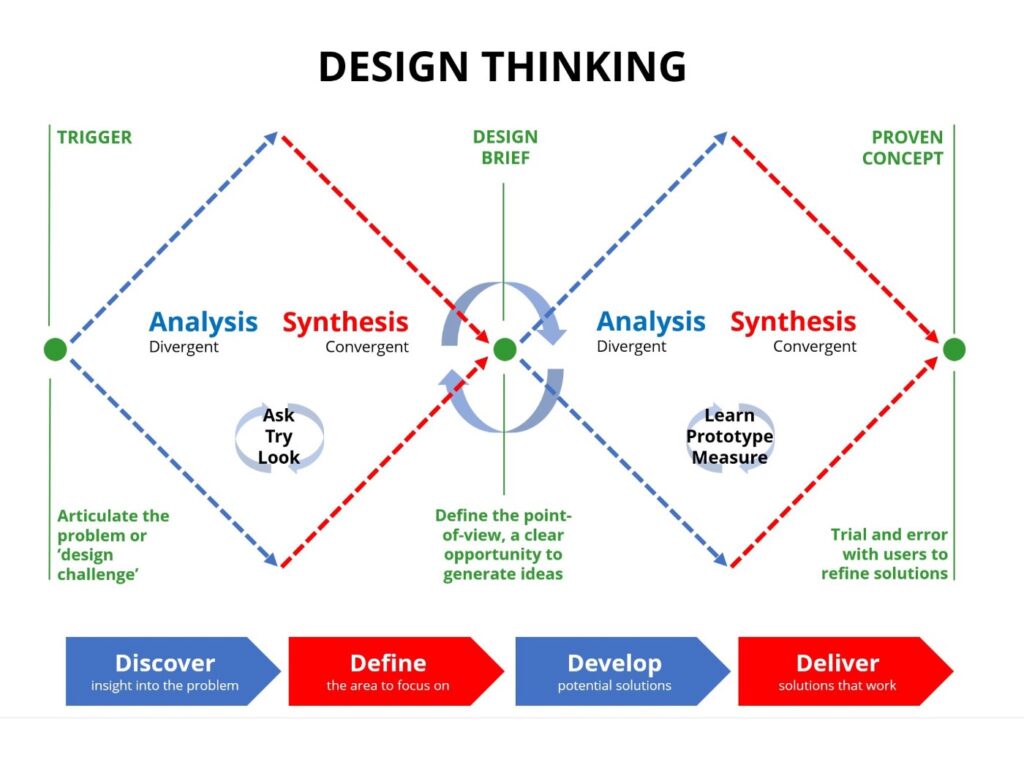
There are multiple UX design frameworks to solve a problem area. I have chosen the Double Diamond Process framework to solve my problem statement. The double diamond framework is divided into problem space and solution space. In the problem space, we discover and define the problems of the users. In the solution space, we develop and deliver the results.
STAGE 1 — DISCOVER
Quantitative/Secondary Research
In this secondary research, I have gone through several articles to gather the behavioral and statistical insights for my problem statement. I have divided all my gathered insights into different categories below.
Impact on the mental health due to lack of travel
- According to travel and leisure, 78 percent of the customers said that travelling is one of the major activities they are missing during the pandemic. While 48 percent of the people suffer from anxiety and depression because of not being able to travel.
- People have suffered from increase in their stress levels due to work and financial matters. Being restricted to home made them feel separated from their loved one’s and have limited freedom.
- The restrictions to stay at home affected the mental health people in the form of insomnia, acute stress, intrusive thoughts, depression etc.
- “The mental health of young adults (18−34 years old) was the most affected by restrictions.”
Motivations of people to travel despite the pandemic situation
- The Human Insight Trends user testing team has found that
- People have started adapting to the new normal life and are planning their holiday besides following the safety precautions.
- Despite the pandemic risk, they are much worried about not having enough memories with their loved one’s if they don’t start planning their holidays.
The impacts experience case study says that
- The motivation of people planning their holiday is mainly for two reasons
- There has been a long wait to visit their family and friends since the start of the pandemic.
- They are very desperate for a change of scenery as they were restricted to their homes since a long time.
According to olyverwyman global survey
- People are confident about their travel due to the safety measures followed by the major brand airlines, hotels etc. across the world.
- 48 percent of the people globally have been awaiting since past one year for leisure travel . This leisure travel includes meeting the friends, family and to just have a change of scenery from the regular constrained routine during the pandemic times.
- 32 percent of the people feel “it is ok to travel now”, as the cases are decreasing and the vaccinations are increasing.
Travelboom survey conducted as of April 2021 says that
- 29 percent of the people are willing to take more trips than they took in 2019 before the pandemic.
- 33 percent of the people are willing to take more vacation days and they want to have longer stays in their planned trips.
- “Nearly 70 percent of those who have travelled, have done so at least twice during the pandemic.”
Choice of destination and mode of transportation
- 72 percent of the people are willing to plan a sustainable travelling after the pandemic to protect the planet.
- 59.8 percent people are willing to visit metropolitan cities, while a 57.9 % people have a desire for change of scenery and a 39.8% people want to visit their family and friends.
- 45 percent of the people wanted to avoid the planes and train journies due to the fear of infection transmission.
- 76 percent will stay away from crowded tourist attractions and prefers alternative destinations to avoid overcrowding. Those destinations will need to adopt new, smart crowd management measures to appease travelers.
- According to booking.com, 63 percent of Indian travelers are excited about traveling again, while 63 percent indicated they are more appreciative of travel now and will not take it for granted in the future.
Factors that stand out as a fear of concern while planning for a travel
People who are willing to travel the post-pandemic have major concerns about the changing safety measures on a daily basis. Here are some of the FAQs by people on different platforms when they are booking a vacation. I have collected the following FAQs from sources like cdc and unicef.
- How often the international travel restrictions will be updated?
- Do I need to be in quarantine after domestic travel?
- Are there any special restrictions while travelling with a family?
- What should we do when we reach the destination?
- Is vaccination mandatory before travelling?
These insights helped me to move forward with the primary research by providing ideas for my user interviews.
Defining the Target Audience
Before the primary research, I set up a target audience by narrowing down the data, which I got from the secondary research. This helped me to define the type of people who could be facing the problems relevant to my problem statement and give direction to move further on the research by getting data from Google searches ( Quora )
There are some questions that I framed for the user interview
- How often do you travel?
- Do you like to travel and spend your holidays on a vacation trip?
- Do you plan a trip beforehand?
- How many days do you think it’s better to spend your vacation?
- Where do you look for the information to plan the trip?
- What kind of places did you visit before the pandemic and what would you like to visit after the pandemic or once it started to drop?
- What motivates you to visit certain places?
- Did it match your expectations?
- What will make you feel safe to travel again?
- To come out of stress, what do you do? Will travel help to improve your mental health?
Note: I framed these questions and virtual users by Google search mainly Quora
Here are some of the key insights from my virtual users
1. This pandemic has been haunting people for almost more than a year due to several reasons. People’s travel plans were canceled due to covid. Once the cases start to drop down: People are expecting to travel again and enjoy their holidays to come out of this pandemic and they want to travel as safely as possible.

2. People already have some expectations of how they can travel safely after the covid or once it starts to slow down to enjoy their vacation. They expressed their feelings and expectations of safety measures while traveling.
“I am worried about the public transports like flights, trains, etc to travel.”
“I am not sure about all the necessities are available or not during this covid like Healthcare centre or hospital, pharmacy, etc for remote places.”
3. People have almost adapted to the new normal and are willing to travel again with the easing covid restrictions but with some considerations. They are thinking about different factors such as the mode of transport, destination to choose, with whom they are traveling, etc.

4. For travel booking, people are using different digital applications. But, they are not sure of the safety instructions, the dos and the don’ts provided by the specific app. They are confused sometimes with the conflicting information.

Some common interview findings from all travelers
1. Usually, for inspiration
- They check YouTube or Instagram
- Travel blogs
- Ask with friends
- Google about the places they want to visit
2. Travelers planning their visits depending on the stay location
3. Travelers prefer to explore some local experiences while traveling
4. To save the information about the places they take screenshots or make word doc before traveling
User sets
I have identified two different user sets from my research findings.
Frequent Travellers
This group is travel lovers who like to travel for at least a month. They find traveling as their stress buster. They are greatly affected by the lockdown situation and are waiting for their next holiday. This group of people is mostly young adults who are single and working and mainly most of them are youtube travel vloggers.
Occasional Travellers
This group of people plans their holiday once or twice a year. They plan their vacation generally with their family to escape from the busy work schedule. They are mostly worried about their family while booking for the holiday.
Empathy Mapping
Empathy mapping helps us to understand what a user actually Says, Thinks, Does, and Feels while interacting with a product. By splitting down the user’s various feelings it gets easier to derive meaningful patterns from user insights. I have made two empathy maps for the frequent and the occasional travelers from the research I have done.
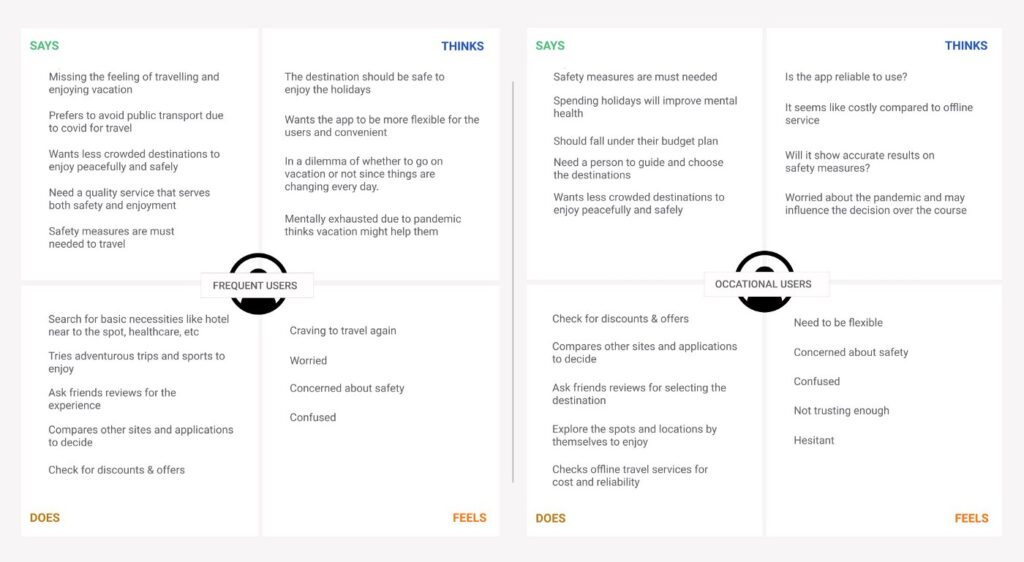
Note: I chose the frequent traveler group to proceed further for solving the problems as it would help in other user groups’ problems also.
User Personas
User Personas are fictional characters that represent my set of target users. To illustrate, it is a representation of my target users Goals, Motivations, Frustrations, etc.
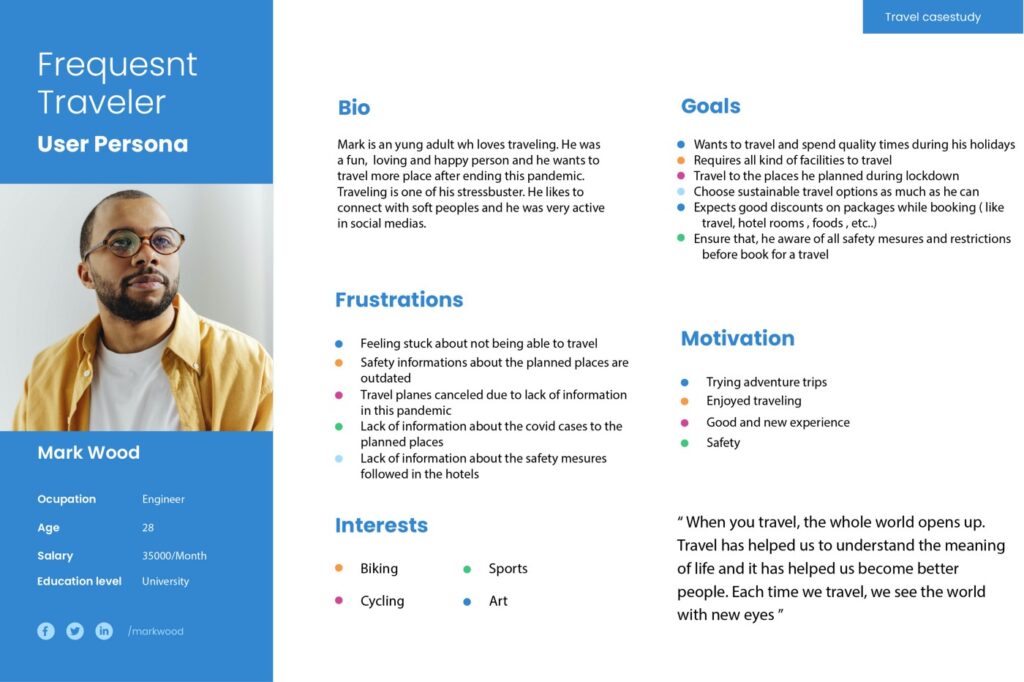
Reframing the user challenges using the ‘How might we’ question
Now that with the Empathy maps and User personas, I got a clear picture of my user’s needs and pain points, it’s time to construct some How Might We questions to narrow down the brainstorming session for solutions. I have written down my user’s problems followed by the How Might We questions to move further for the brainstorming session.
Users are much worried about using public transport due to travel during covid times.
How might we ensure the safety of users and bring confidence in them while traveling through public transport like buses, trains, flights, etc?
Users are not fully convinced to travel again due to several safety reasons.
How might we assure the users that they can travel safely and give a sense of safety?
Not sure about all the basic necessities are available or not during this covid like Healthcare center or hospital, pharmacy, etc.
How might we inform users about all the necessities are available to travel safely?
Users are frustrated about not having any border restrictions information and no proper instructions to be followed when crossing borders?
How might we provide accurate information when crossing the borders?
STAGE 3 — DEVELOP
IDEATION
With the How Might We questions in hand, it is now time for brainstorming for the user’s problems. After carefully scoping down the data that I got till now, I have come up with the following solutions for my user’s problems.
Covid Safety verified badge — All of my users are majorly worried about the clear data missing about the vaccination details, hygiene followed, percentage of occupancy, etc. I have come up with the idea of assigning a trust badge to the Hotels, Transport services, and restaurants that verify the following.
User community — A user community feature like social media will be included for the users to engage with other users to get references and reviews for their trips.
Road trip mode — The application would include a road trip mode feature for people who are worried about using public transport for their travel. It will have a map that will show a verified route to the user along with verified restaurants and spots to spend their time during the travel.
Note: For interview purposes, I started this project and I suggested 3 ideas to solve the user pain points. Since I would like to complete this project after completing my interview process. I Consider this as a live project and work accordingly in future.
Major takeaways from this project
It was an overall roller coaster ride for me throughout this project since 3rd wave of covid is going on.
- One of the major things I learned is to unlearn to be perfect. I tried to be perfect for each phase of the project, but over the course, I realized it’s better to not worry about providing perfect work, since we can iterate and test our work with the users.
- I have also learned that research is where the real answers can be found. With good research, more than half of our problems are already solved.
After finishing this project, when I looked back I realized that it’s been a huge learning experience for me throughout the course. Since this is my first UX Research project. Overall, I unlearned and learned a lot!


